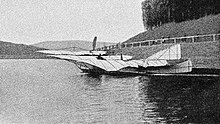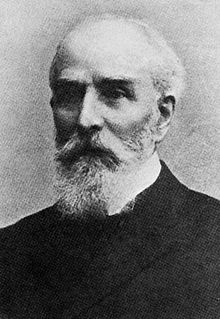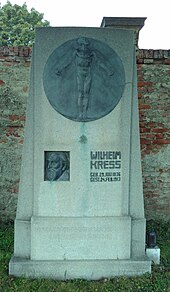Wilhelm Kress
Wilhelm Kress (also Wilhelm Kreß ) (born July 29, 1836 in Saint Petersburg , † February 24, 1913 in Vienna ) was an Austrian aviation pioneer and designer . In 1901 he built a motorized airplane on the Wienerwaldsee, west of Vienna, but the seaplane capsized during test drives without ever taking off.
Life

Kress, a child of German parents in what was then the Russian capital Saint Petersburg, learned the trade of piano maker and moved from Erfurt to Vienna in 1873 , where he attended lectures at the Imperial and Royal Technical University and in 1877 made the first free-floating model of a hang-glider fly. It was powered by twisted rubber threads after Kress had already experimented with clock springs and other things (and built his first propellers as early as 1864 ), which all turned out to be too difficult. Until then, the rule was that humans could not fly through anything “heavier than air”. Kress showed the model to the physics professor and president of the Vienna Academy of Sciences Josef Stefan in Vienna and, on his advice, left a description there to secure his priority rights. Kress was also promoted by the famous physicist Ludwig Boltzmann in Vienna, who used Kress's models in his lectures (including about Luftschiffahrt in 1894 at the natural scientist meeting in Vienna). Boltzmann also gave him financial support to build a larger model propeller with an electric motor in 1895.
Kress also wrote a book Aviation and influenced the experiments of, for example, Hiram Stevens Maxim in England and Otto Lilienthal in Germany. Around 1900 he invented the joystick for combined control.
From 1898 to 1901 he constructed the Kress'schen hang glider, a motorized three - decker with two propellers rotating in opposite directions. He opted for a seaplane as he could not find a suitable place on land to attempt take-offs and hoped the water would limit the effects of any accidents. Kress expected a take-off weight of 600 kg with an engine output of at least 30 hp. Since no suitable engine could be found in Austria, Kress ordered an airship engine from Daimler-Motoren-Gesellschaft in Stuttgart , which, however, was late in delivering an engine that weighed 380 kg instead of 200 kg and only made about 30 hp instead of 35 hp. Due to the overweight of the engine, Kress also had to add further reinforcements to the aircraft, which ultimately came to a take-off weight of 850 kg. It was perfectly clear to Kress that with such a mismatch between weight and performance, he would never reach the speed necessary to take off. However, he wanted to use the aircraft at least for test drives on the lake. However, the swimmers were very deep in the water because they were not designed for this heavy weight. Due to the small size of the lake, Kress had to make a sharp turn after every attempt to accelerate in order not to collide with the dam . On October 3, 1901, after the fourth attempt, a wing touched the water surface during such a sharp turn, whereupon the aircraft capsized and sank. Wilhelm Kress was rescued from the water unharmed. The wreck of the aircraft was recovered after three days, which at least saved the irreplaceably expensive engine for Kress.
In the summer of 1902 a new hang-glider was completed, but due to financial difficulties regarding the covering of the wings and the transfer to Lake Neusiedl , the project had to be discontinued. The flying machine was brought to the Vienna Arsenal on October 10, 1904 . In the same year Kreß was naturalized in Austria .
Kress, who had a heart condition, was plagued by paralysis in the last few weeks of his life. Serious flu led to pneumonia and Kreß, being looked after by his wife and daughter, passed away on the evening of February 24, 1913 at his place of residence, Schüttelstrasse 75, Vienna-Leopoldstadt . His body was consecrated on February 27, 1913 in the Lutheran City Church , Dorotheergasse 18, Vienna Inner City , and then solemnly buried in the Vienna Central Cemetery in an honorary grave (at the expense of the Vienna City Council).
On October 5, 1913 , a memorial made by the sculptor Rudolf von Weigl († 1926/27), a pupil of Hellmer , was unveiled in his honor on the northern shores of the Wienerwaldsee (then: Tullnerbachbassin) , and Tullnerbach , part of the lake in its municipality the Kress air screw included in the municipal coat of arms. In Tullnerbach the Wilhelm Kress-Promenade and the Kressgasse are named after the aeronaut, in Vienna- Simmering (11th district) the Wilhelm-Kreß-Platz and the Wilhelm-Kreß-Weg . In Salzburg can be found in the district of Taxham the Wilhelm Kress Street , further on Bindermichl in Linz of Kressweg. In Guntramsdorf , Wilhelm-Kreß-Gasse is located in an area where street names are reminiscent of inventors and technology pioneers.
His honorary grave designed by the sculptor Andreas Kögler (1878–1956) is located in the Vienna Central Cemetery (Group 0, Row 1, Number 65).
Fonts
- Aërovéloce. Steerable flying machine, invented and described . Bondi and Schmid, Vienna 1880, OBV .
- Aviation. How the bird flies and how man will fly . Spielhagen & Schurich, Vienna 1905, OBV .
- The first development of the hang glider in Vienna, in response to Lieutenant Colonel Hoernes . Self-published, Vienna 1912, OBV .
literature
- Hans Christoph Graf von Seherr-Thoss: Kreß, Wilhelm. In: New German Biography (NDB). Volume 13, Duncker & Humblot, Berlin 1982, ISBN 3-428-00194-X , p. 9 f. ( Digitized version ).
- Sperr: Kress Wilhelm. In: Austrian Biographical Lexicon 1815–1950 (ÖBL). Volume 4, Publishing House of the Austrian Academy of Sciences, Vienna 1969, p. 261 f. (Direct links on p. 261 , p. 262 ).
- Günter Schmitt, Werner Schwipps: Pioneers of early aviation . Gondrom, Bindlach 1999, ISBN 3-8112-1189-7 .
Web links
- Entry on Wilhelm Kress in the Austria Forum (in the AEIOU Austria Lexicon )
- Airship travel. The Kress flying machine. In: Allgemeine Sport-Zeitung. Weekly for all branches of sport , year 1900, January 28, 1900, No. 4/1900 (XXI. Year), p. 91, top right. (Online at ANNO ). .
- Airship travel. The Kress hang-glider. In: Allgemeine Sport-Zeitung. Weekly for all branches of sport , year 1900, May 6, 1900, No. 26/1900 (XXI. Year), p. 433 middle. (Online at ANNO ). .
- The hang-glider of the engineer Kress. With two illustrations. In: Illustrirte Rundschau , No. 4/1901 (XII. Volume), February 1, 1901, p. 1. (Online at ANNO ). .
Individual evidence
- ↑ a b c airship travel. Wilhelm Kress †. In: Allgemeine Sport-Zeitung. Weekly for all branches of sport , year 1913, March 2, 1913, No. 9/1913 (XXXIV. Year), p. 236 ff. (Online at ANNO ). .
- ↑ Ludwig Boltzmann: About air shipping. (Lecture given in the Society of German Natural Scientists and Doctors in Vienna, 1894) . In: -: Popular writings . Barth, Leipzig 1905, pp. 81–91.
- ^ First airplane with a Daimler internal combustion engine. In: M @ RS. Mercedes-Benz Classic, 1901, accessed on March 22, 2017 (photo with comment): “However, there was no flight because Wilhelm Kress let the engine run with barely 500 rpm. He used a maximum of 15 HP of the available 35 HP engine power. "
- ^ The aeronautical events. Unveiling of the Kreßdenkmal. In: Neues Wiener Tagblatt. Democratic Organ , No. 270/1913 (XLVII. Volume), October 2, 1913, p. 11, bottom right. (Online at ANNO ). .
- ↑ Hedwig Abraham (Red.): Ing.Wilhelm Kress . In: viennatouristguide.at , accessed on March 22, 2017.
| personal data | |
|---|---|
| SURNAME | Kress, Wilhelm |
| BRIEF DESCRIPTION | Austrian aviation pioneer and designer |
| DATE OF BIRTH | July 29, 1836 |
| PLACE OF BIRTH | St. Petersburg |
| DATE OF DEATH | February 24, 1913 |
| Place of death | Vienna |


